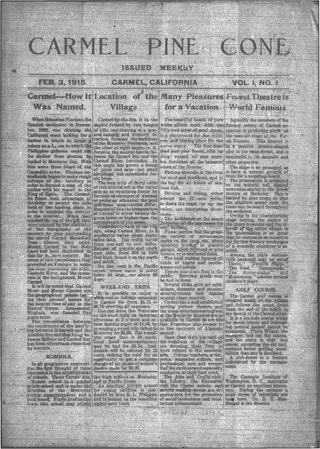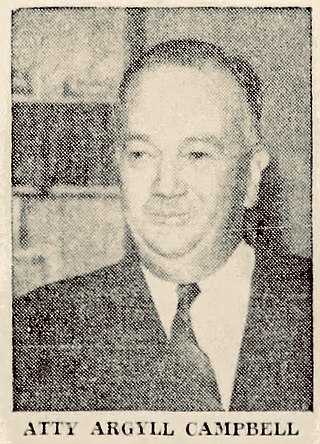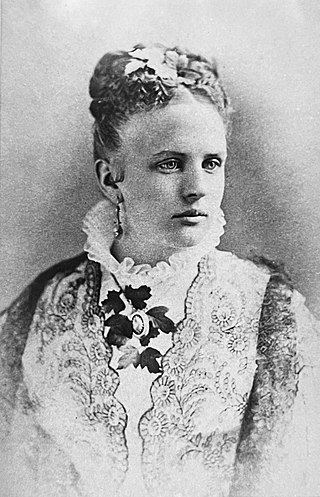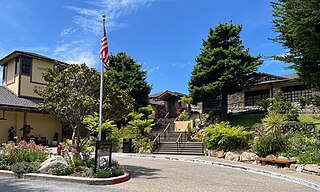
Carmel Highlands is an unincorporated community in Monterey County, California, United States. It is 3.5 miles (5.6 km) south of Carmel-by-the-Sea, at an elevation of 318 feet. Carmel Highlands is just south of the Point Lobos State Reserve, and serves as the northern gateway of the Big Sur coastline along California State Route 1. Carmel Highlands was laid out in 1916 by developers Frank Hubbard Powers and James Franklin Devendorf and the Carmel Development Company.

The Carmel Pine Cone is a small weekly Californian newspaper. It serves the city of Carmel-by-the-Sea and the surrounding Monterey Peninsula, Carmel Valley and Big Sur region of Monterey County in central California. The paper is known for red-baiting.

Frank Hubbard Powers, served in the California State Assembly for the 41st district from 1895 to 1897. He was a San Francisco attorney for Heller & Powers. He and real estate developer James Franklin Devendorf (1856-1934), founded the Carmel Development Company in 1902. They established an art colony that became Carmel-by-the-Sea, California, which included the Carmel Highlands, California.

Santiago Jacob Duckworth, known locally as S. J. Duckworth, served in the California State Assembly for the 61st district from 1893 to 1895. He was as an early Monterey pioneer businessman, real estate developer, and visionary of the short-lived Carmel City. In 1889, he wanted to build a Catholic summer resort, bought the rights to develop the area, filed a subdivision map, and started selling lots. After an unsuccessful undertaking, he sold the property to James Franklin Devendorf in 1902, who went on to found the Carmel Development Company and Carmel-by-the-Sea, and the Carmel Highlands in California, United States. Duckworth helped shape the early development of Carmel, bringing the first major developers and builders, and attracting some of the first residents.

Honoré Escolle, was as a French businessman from Monterey, California. He was an early pioneer who became a significant landholder in Monterey County. In 1878, he purchased 1,400 unsettled acres (570 ha) acres of the Sanchez's ranch near Gonzales, California. In the late 1880s, he sold 324 barren acres (131 ha) to Santiago J. Duckworth to build a Catholic Summer resort. This land later became Carmel-by-the-Sea, California

Argyll Campbell was city attorney for Carmel-by-the-Sea, California from 1920 to 1937. He was former chairman of the California Democratic Party to elect governor Culbert Olson. Campbell was a leader in Monterey Peninsula civic life for twenty-eight years. He was known for his efforts to "keep Carmel from radical change."
The Carmel Development Company was a real-estate development company that operated in Carmel-by-the-Sea, California from 1902 to 1965. It was developed by James Franklin Devendorf and Frank Hubbard Powers in 1902. Powers provided the capital and did the legal work of the corporation. Devendorf was the general manager and oversaw subdividing and developing the land. Between 1900 and 1910 the Carmel Development Company purchased parcels of land.

The La Playa Hotel, also known as the "Grande Dame of Carmel," is a historic two-story hotel in Carmel-by-the-Sea, California, once owned by artist Chris Jorgensen. The building is an example of Mediterranean Revival architecture. The building qualified as an important commercial building and was registered with the California Register of Historical Resources on September 21, 2002.
The following is a timeline of the history of Carmel-by-the-Sea, California, United States.

Abigail Jane Hunter, (1855–???) was as an early pioneer businesswoman, real estate developer, and visionary of Carmel-by-the-Sea. She is best known as Carmel's first woman real estate developer and important contributor in Carmel's early years. In 1889, she worked with Santiago James Duckworth to help build a Catholic summer resort called Carmel City. Hunter is credited with coining the name Carmel-by-the-Sea and utilizing it in promoting Carmel City through newspaper advertisements and postcard mailers. After an unsuccessful undertaking, she sold her Carmel holdings in 1900.

Carmel Point also known as the Point and formerly called Point Loeb and Reamer's Point, is an unincorporated community in Monterey County, California, United States. It is a cape located at the southern city limits of Carmel-by-the-Sea and offers views of Carmel Bay, the mouth of Carmel River, and Point Lobos. Carmel Point was one of three major land developments adjacent to the Carmel city limits between 1922 and 1925. The other two were Hatton Fields, 233 acres (94 ha) between the eastern town limit and Highway 1, and Carmel Woods, 125 acres (51 ha) tract on the north side.

Joseph W. Hand, was an early pioneer businessman, real estate agent, leader in civic affairs, actor, and first president of the Forest Theater in Carmel-by-the-Sea.

James Cooper Doud was an American businessman and real estate developer in Carmel-by-the-Sea, California. He established the Doud Building in 1932, built by master builder Michael J. Murphy. He also owned The Doud Arcade, a two-story commercial building built in 1961 that connects with The Doud Craft Studios.

Lee Gottfried was an American master builder in Carmel-by-the-Sea, California. He had a significant influence on the architecture of the Village of Carmel during his career. Gottfried was one of the main local builders in Carmel and responsible for the first major residential designs done using the local Carmel stone as a building material.
Percy Parkes was an American master builder in Carmel-by-the-Sea, California. Parkes was one of the main progressive builders in Monterey County through the 1920s and 1930s, and the first contractor to build homes on Scenic Drive. His best known commercial buildings are the Seven Arts Building (1928), the Dummage Building (1924), and the Percy Parkes Building (1926). His American Craftsman-style, influenced by the Arts and Crafts movement, is evident in the buildings he constructed during that time.

Robert R. Jones was an American architect in Carmel-by-the-Sea, California best known for his Modern architecture. Jones designed numerous residences and commercial buildings in the Monterey Peninsula. In the post-war period, he emerged as a prominent figure among architects and designers who played a pivotal role in shaping Carmel's modernist landscape from the middle 20th century onward. His was known for his design aesthetic that was a Modern architecture-style, combined with elements from the Second Bay Tradition. His creation, the Monterey Airport Administration building, was honored with a design award by the Smithsonian Institution.

Highlands Inn is a historic resort hotel located in Carmel Highlands, California. Constructed in 1917 by Frank Devendorf, one of the early co-founders of Carmel-by-the-Sea and a real estate developer, the inn was built on land acquired in 1906 from local ranchers, south of Point Lobos. This establishment is part of the Hyatt Hotels Corporation.
















